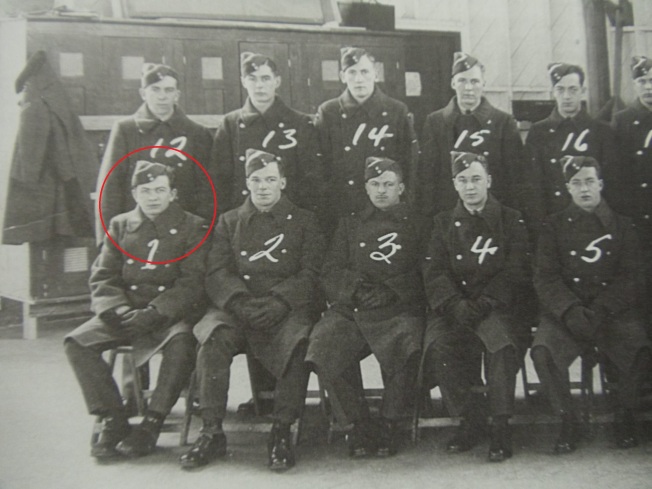Mr. Todd had little to say about his stay at No. 1 Manning Depot and no pictures to show and tell. This is what he told me…
It took seven days to prepare the grounds to “welcome” back the horses and the cattle for the exhibition, and only one to prepare the grounds for the recruits when they got back.
There are several descriptions on the Internet on how life was for recruits at No. 1 Manning Depot in Toronto. Here’s one description…
The source is here.
Training of Ground Crew Trades
The mightiest and most powerful air forces would soon find themselves short of serviceable aircraft if it were not for members of the ground crew who maintained, repaired and in their eyes “owned” the aircraft that the aircrews “borrowed”. At Recruitment Centers across Canada the recruits for these trades were judged on their work backgrounds and aptitude tests. Although some knew what trades they wanted to be trained to from the very start others were steered into what was thought to suit them. And being the military what you wanted and what you were best suited for was not always where you ended up.
Manning Depots
Once accepted and upon receiving orders by mail they headed to their Recruiting Office. From there they would be sent to one of the many Manning Depots around Canada. The two primary ones at the begining being Brandon Manitoba and Toronto, with more added as the war went on.
For those lucky enough to be sent to Toronto it would provide them many great places to see and visit. If you could get a pass for the night, which were not all that freely given out from what my father wrote. And of course there were the lavish accommodations provided at No. 1 Manning Depot in the Canadian National Exhibition fair grounds namely the Equine Building or what most called the Horse building. Four to a stall and as my father wrote the horses had a better deal, they at least each got their own stall. My father had been a stable boy in his youth and many of the recruits were from rural towns and farms to them it was familiar if not fully comfortable. To the city born recruits, even without there being many horses in the building, they found the accommodations more colourful and aromatic then they were used to.
Manning Depots took the civilian and, as my father wrote, ever so gently awakened them to the pleasures of military life. It was the place where you were given uniforms that didn’t fit and needles you didn’t want in places that were already aching from the last needle. The new recruits were taught marching, saluting, personal grooming, hygiene and basically learning the ways of military life as the bottom peg in a system. For my father it was not completely new. His whole family had been Seaforth Highlanders for many generations.
Training for some of the new comers was transferred abruptly from Toronto to Brandon. So my dad and a whole train load of recruits left sunny oh so a warm Toronto late in the fall and arrived in the middle of a blizzard in Brandon with only their Summer dress uniforms to wear. Brandon didn’t have all the amenities of Toronto, but it didn’t matter. Passes were still just as stingingly handed out here as they had been in Toronto.
Another one here…
To start with, they sent us to manning depot in Toronto, and we arrived there, and then, you know, you were allowed one suitcase when you left home, so you packed, you got into your best suit, best coat, best shoes, and all your best things were in the suitcase, and you went to Toronto and six of us from Saskatoon, went together. In manning depot, the manning depot was housed in the Toronto Exhibition grounds, in the various cattle barns and the horse barns. Well, the winter fair has just finished when we arrived, and I recall we were all lined up and a sergeant came out and said, “Okay,” he said, “First of all, how many of you here can ride a motorcycle?” So a number of eager chaps stepped out and they were marched off and we were marched off behind them in our suits, civilian clothing. They were all handed a wheel barrow and we were handed pitch forks and shovels and brooms and we cleaned out the stables, the stalls in the horse barns.
Last one… and I guess you get the picture…
Life at manning depot was strenuous, rigorous, and gave recruits their first introduction to military discipline and organization. Flight Lieutenant Asbaugh describes the daily regime of life at manning depot, which he remembers as being a shock to new recruits unused to military life:
Manning depot was quite a shock…It was our first introduction to the air force and military discipline…We were in the cow barn, in double-tiered bunks. There was just a mass of people in there…And we had drillsand marching, and learnt to use the Ross rifle, and all that good stuff…The food was terrible; it was really shocking…They had some sort of arrangement with a caterer, and he could make the best rubber eggs you ever had in your life. The one thing that was really good about it was you got all the milk you could drink and all the bread and butter you wanted. The rest of the food was bad.
About some pictures…
I found these two on the Internet.


This one is from Walter Neil Dove’s collection.
He was a Spitfire pilot with 403 Squadron.




































